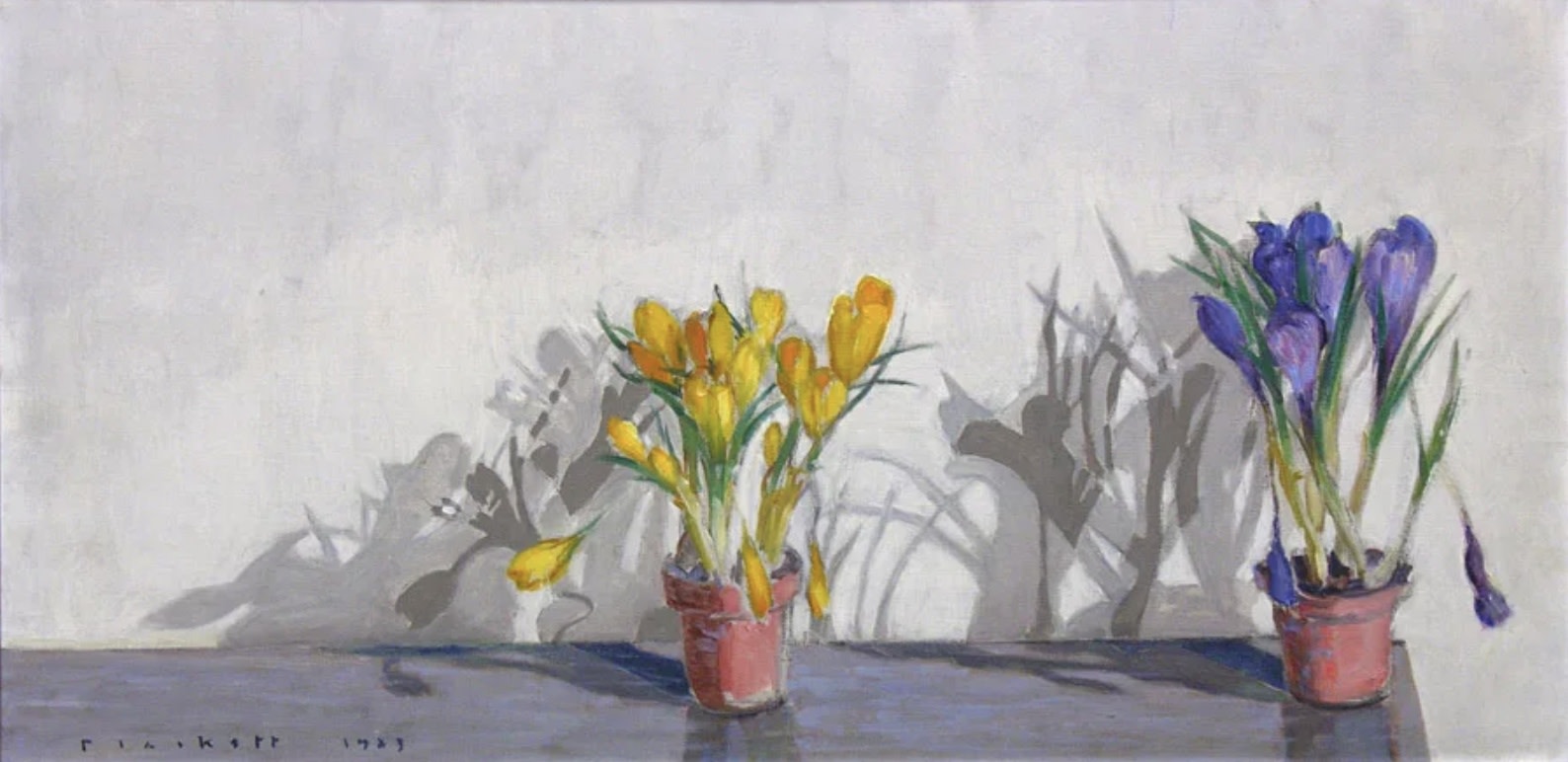Joseph Plaskett, O.C., R.C.A.
On Thursday, February 14th, Galerie Walter Klinkhoff will be opening an exhibition of works by Joseph Plaskett. This exhibition and sale will be posted on klinkhoff.ca at approximately 12pm, with select works on view at the gallery. We invite you to purchase one of these outstanding compositions by the master.

Crocuses with Double Shadow, #3, 1986 | Oil on canvas 15.75 x 31.5 in.
Please note that all works are subject to prior sale.
Joseph Plaskett, born in New Westminster, BC in 1918, was originally influenced by Emily Carr and later by Bonnard, Matisse, Monet and Picasso as well. He studied in both San Francisco and New York, the latter experience turning into a disciple of abstract expressionist Hans Hofmann. While living abroad since 1953, primarily in Paris, France but more currently in Suffolk, England Plaskett has pursued a constantly evolving figurative style now for more than 50 years exhibiting almost exclusively in Canada from coast to coast where his work is owned in countless collections of fine art.
In his own words:
"In 1949 I went to Paris and eventually stopped trying to be an abstract painter and gradually developed a personal figurative manner. I had turned against my own development and training that would have led me to remain a member of the avant gard. I defended my position by writing articles published in Canadian Art, two of them in praise of what I called "reactionaries", artists who seemed to have turned against the acclaimed trends of the time, or at least leaving behind abstraction, like Balthus, Bacon and Giacometti."1 "Oh yes, I was schooled in Modern Art, and as a result my work, however appearance may belie it, is modern and in the stream of a great tradition which goes back to Giotto, Michelangelo, Rembrandt, Courbet, Cezanne and on to Matisse and now me! Modern Art has been proclaimed dead, meaning that its masters like Picasso are dead. It has been replaced by Contemporary Art. It has entered into history. Abstract art is not dead, because all great art is inherently abstract. We now have Conceptual Art. All great art was conceptual. What greater concept can you imagine than the Sistine Chapel, or Botticelli's Birth of Venus?"2 " . . . the delight of being an artist - the lure of the unimaginable and with it the possible realization of vision."3
About and by Joe Plaskett
"Plaskett talks of "the peculiar way in which I deal with light, drowning the canvas and floating the form," and this is what one seems to perceive on seeing a painting of his in colour. "I interpret the subject through light," he also says, "but the object or person is there, the essential subject matter." But light in the sense of the often almost translucent luminosity of his paintings is not the only lightness of mood, almost a lightness of being, that is evident in these works which range from pastel through watercolour to - perhaps his most habitual way of painting - oil so light in texture as well as in tone and mood that it has a fluency one rarely sees anywhere but in watercolour, a lightness only a few of the late Impressionists equalled. It is at this point, talking about such a central attribute of his painting a "light" and "lightness" that Joe Plaskett comes nearest to a statement of philosophic intent or perhaps non-intent. "In my world," he tells us, "lightness eliminates the dark and a spirit of joy seeks to banish any pain. Escapism? Rather a concentration on a very real side of life." It is significant that he has found his opposite in Francis Bacon, that painter of irremediable agony and darkness."4
About Joe Plaskett
"Plaskett has been left free to pursue his passion for light and colour and their emotional coordinates in forms and genres which the great artists of the past followed but which were rejected by the recent apostles of pure form. He is, without excuse, a landscapist, a painter of still-life and a portraitist who seeks the other largely in himself. Seeking is essential to Plaskett's aesthetic viewand equally to his painterly methods."5
Footnotes:
1. Speech delivered by Joseph Plaskett to the Vancouver Society of Contemporary Art , undated, circa 1996.
2. ibid.
3. Plaskett, J., A Speaking Likeness, Ronsdale Press Ltd., 1999, p. 295.
4. Plaskett, J., A Speaking Likeness, Ronsdale Press Ltd., 1999, Woodcock, G., Foreword, p. xxvii.
5. ibid, p. xviii.
Copyright © Galerie Walter Klinkhoff






Add a comment